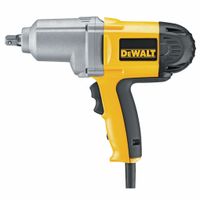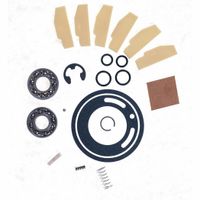Call +(254) 703 030 000 / 751 483 999 / 721 704 777
- Home
- Tools
- Power Tools
- Impact Wrenches Power Torque Wrenches Power Ratchets
- Impact Wrenches
.....Read More
Frequently Asked Questions
What is the difference between an impact wrench and a regular drill?
An impact wrench and a regular drill differ primarily in their function, mechanism, and application.
An impact wrench is a power tool designed to deliver high torque output with minimal exertion by the user. It achieves this through a hammering mechanism that delivers strong, sudden rotational and downward force. This makes it ideal for tasks requiring high torque, such as loosening or tightening nuts and bolts, especially in automotive and heavy machinery applications. Impact wrenches are typically powered by compressed air, electricity, or batteries and are available in various sizes to accommodate different tasks.
In contrast, a regular drill is a versatile tool primarily used for drilling holes and driving screws. It operates using a continuous rotational motion without the hammering action found in impact wrenches. Regular drills are suitable for woodworking, metalworking, and general home improvement tasks. They come in corded and cordless versions, with various speed and torque settings to handle different materials and applications.
The key differences lie in their torque delivery and intended use. Impact wrenches provide higher torque and are better suited for heavy-duty applications, while regular drills offer precision and control for lighter tasks. Additionally, the internal mechanisms differ: impact wrenches use a hammer and anvil system, whereas drills use a simple motor-driven chuck. This distinction affects their performance, with impact wrenches excelling in tasks requiring brute force and drills being more appropriate for precision work.
How do I choose the right size impact wrench for my needs?
To choose the right size impact wrench, consider the following factors:
1. **Application**: Determine the tasks you need the impact wrench for. Light-duty tasks like automotive repairs may require a 1/4-inch or 3/8-inch wrench, while heavy-duty tasks like construction or industrial work may need a 1/2-inch or larger.
2. **Torque Requirements**: Check the torque specifications of the bolts or nuts you will be working with. Ensure the impact wrench provides sufficient torque. A 1/2-inch wrench typically offers 300-500 ft-lbs, suitable for most automotive tasks, while larger sizes can provide over 1,000 ft-lbs for industrial applications.
3. **Power Source**: Decide between pneumatic (air-powered), electric (corded), or battery-powered (cordless) wrenches. Pneumatic wrenches are powerful and suitable for continuous use but require an air compressor. Corded electric wrenches offer consistent power without the need for recharging, while cordless models provide portability and convenience.
4. **Weight and Ergonomics**: Consider the weight and design of the wrench, especially if you will be using it for extended periods. A lighter, ergonomically designed wrench reduces fatigue and improves control.
5. **Budget**: Set a budget based on your needs. Higher torque and advanced features typically increase the cost. Balance your budget with the required performance and durability.
6. **Brand and Reviews**: Research reputable brands and read user reviews to ensure reliability and performance. Brands like DeWalt, Milwaukee, and Ingersoll Rand are well-regarded in the industry.
7. **Additional Features**: Look for features like variable speed control, LED lights, and brushless motors for enhanced performance and convenience.
By evaluating these factors, you can select an impact wrench that meets your specific needs effectively.
Can I use regular sockets with an impact wrench?
No, you should not use regular sockets with an impact wrench. Regular sockets are designed for hand tools and are not built to withstand the high torque and vibrations produced by impact wrenches. Using them can lead to several issues:
1. **Material Strength**: Regular sockets are typically made from chrome vanadium steel, which is not as strong as the chrome molybdenum steel used in impact sockets. This makes them more prone to cracking or shattering under the stress of an impact wrench.
2. **Wall Thickness**: Impact sockets have thicker walls to handle the increased force. Regular sockets have thinner walls, which can deform or break when subjected to the high torque of an impact wrench.
3. **Design**: Impact sockets have a black oxide or phosphate finish to prevent corrosion and are designed to absorb shock. Regular sockets have a polished finish that can chip or wear off under impact conditions.
4. **Safety**: Using regular sockets with an impact wrench can be dangerous. If a socket breaks, it can send metal shards flying, posing a risk of injury.
5. **Performance**: Impact sockets are designed to fit more snugly on fasteners, reducing the risk of rounding off bolt heads or nuts. Regular sockets may not provide the same level of grip under high torque.
For these reasons, it is essential to use impact sockets with an impact wrench to ensure safety, performance, and the longevity of your tools.
What are the advantages of using a cordless impact wrench over a corded one?
1. **Portability**: Cordless impact wrenches offer greater mobility as they are not tethered to a power outlet, allowing users to work in remote locations or areas without easy access to electricity.
2. **Convenience**: Without the need for a power cord, users can maneuver more freely around their workspace, reducing the risk of tripping hazards and the hassle of managing long cords.
3. **Versatility**: Cordless models can be used in a variety of settings, from automotive repair to construction, without the need for additional power sources or generators.
4. **Ease of Use**: The absence of a cord simplifies setup and operation, making it quicker to start and finish tasks, especially in tight or awkward spaces.
5. **Advancements in Battery Technology**: Modern lithium-ion batteries provide longer run times and faster charging, making cordless impact wrenches more efficient and reliable for extended use.
6. **Reduced Noise and Vibration**: Many cordless models are designed to operate more quietly and with less vibration, enhancing user comfort and reducing fatigue during prolonged use.
7. **Safety**: The lack of cords minimizes the risk of electrical hazards and accidents related to tripping over cables.
8. **Compact Design**: Cordless impact wrenches are often more compact and lightweight, making them easier to handle and store.
9. **Flexibility in Power Source**: With interchangeable batteries, users can switch batteries between different tools, maximizing the utility of their power tool collection.
10. **Environmental Considerations**: Cordless tools eliminate the need for fossil fuel-powered generators in remote locations, reducing carbon emissions and environmental impact.
How much torque do I need in an impact wrench for automotive work?
For automotive work, the torque requirement for an impact wrench can vary depending on the specific tasks you intend to perform. Generally, a torque range of 100 to 1,000 foot-pounds (ft-lbs) is suitable for most automotive applications.
1. **Light-Duty Tasks**: For tasks such as removing or tightening small bolts and nuts, a torque of around 100 to 200 ft-lbs is sufficient. This is typically adequate for interior work or small engine components.
2. **Medium-Duty Tasks**: For more common automotive tasks like changing tires or working on suspension components, an impact wrench with a torque range of 200 to 400 ft-lbs is recommended. This range is effective for lug nuts and other medium-sized fasteners.
3. **Heavy-Duty Tasks**: For more demanding jobs, such as working on large trucks, heavy machinery, or rusted and seized bolts, an impact wrench with a torque of 400 to 1,000 ft-lbs may be necessary. This ensures you have enough power to handle stubborn fasteners.
4. **Versatility**: If you want a tool that can handle a wide range of tasks, consider an impact wrench with adjustable torque settings. This allows you to tailor the torque output to the specific job, preventing over-tightening or damage to components.
5. **Power Source**: Consider whether you prefer a pneumatic, electric, or battery-powered impact wrench. Pneumatic wrenches often provide higher torque and are common in professional settings, while electric and battery-powered models offer convenience and portability.
Ultimately, the right torque depends on the specific automotive tasks you plan to undertake. It's important to choose an impact wrench that provides enough torque for your needs while also considering factors like weight, size, and ease of use.
How do I maintain and care for my impact wrench?
To maintain and care for your impact wrench, follow these steps:
1. **Regular Cleaning**: After each use, wipe down the exterior with a clean cloth to remove dust and debris. Use compressed air to blow out any particles from vents and crevices.
2. **Lubrication**: Regularly lubricate the moving parts. For pneumatic impact wrenches, add a few drops of air tool oil into the air inlet before each use. For electric models, check the manufacturer's guidelines for lubrication points.
3. **Inspect and Tighten**: Periodically inspect the tool for loose screws or bolts and tighten them as needed. Check for any visible damage or wear.
4. **Check the Air Supply**: For pneumatic wrenches, ensure the air compressor is providing the correct pressure and volume. Use a filter and regulator to maintain clean and dry air supply.
5. **Battery Care**: For cordless models, charge the battery according to the manufacturer's instructions. Avoid overcharging and store batteries in a cool, dry place.
6. **Storage**: Store the impact wrench in a clean, dry environment. Use a protective case if available to prevent dust accumulation and physical damage.
7. **Regular Servicing**: Follow the manufacturer's recommendations for servicing intervals. This may include professional maintenance or part replacement.
8. **Use Proper Accessories**: Always use the correct sockets and accessories designed for impact wrenches to prevent damage to the tool and ensure safety.
9. **Avoid Overloading**: Do not exceed the tool's torque capacity. Use the appropriate settings for different tasks to prevent motor strain.
10. **Safety Checks**: Before use, ensure all safety features are functional, and the tool is in good working condition.
By following these steps, you can extend the lifespan of your impact wrench and ensure it operates efficiently.
What safety precautions should I take when using an impact wrench?
1. **Read the Manual**: Familiarize yourself with the manufacturer's instructions and safety guidelines specific to your impact wrench model.
2. **Wear Protective Gear**: Use safety glasses to protect your eyes from flying debris, and wear gloves to safeguard your hands from vibrations and sharp edges.
3. **Inspect the Tool**: Check the impact wrench for any signs of damage or wear, such as frayed cords or loose parts, before use.
4. **Secure the Workspace**: Ensure the work area is clean, well-lit, and free of any tripping hazards. Keep bystanders at a safe distance.
5. **Use the Correct Socket**: Only use impact-rated sockets and accessories to prevent breakage and ensure a secure fit.
6. **Check Air Pressure**: For pneumatic wrenches, verify that the air pressure is within the tool's specified range to avoid overloading.
7. **Maintain a Firm Grip**: Hold the tool securely with both hands to maintain control and prevent accidental slips.
8. **Avoid Over-Tightening**: Be cautious not to over-tighten fasteners, which can lead to damage or breakage. Use a torque wrench for precise torque settings.
9. **Disconnect Power Source**: When not in use or when changing sockets, disconnect the tool from its power source to prevent accidental activation.
10. **Stay Alert**: Remain focused and avoid using the tool if you are tired or under the influence of substances that impair judgment.
11. **Regular Maintenance**: Keep the tool clean and lubricated as per the manufacturer's recommendations to ensure optimal performance and longevity.
12. **Avoid Loose Clothing**: Wear fitted clothing to prevent entanglement with moving parts.
13. **Use in Well-Ventilated Areas**: If using a pneumatic wrench, ensure proper ventilation to avoid inhaling exhaust fumes.


